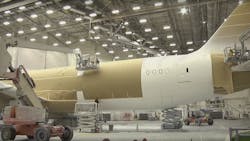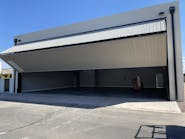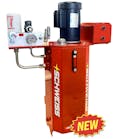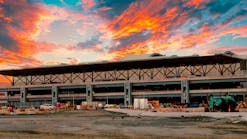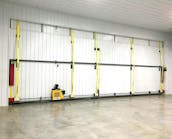How to Keep Pace With Fire Protection for Aircraft Maintenance Hangars
Commercial and military aircraft MRO operations play a huge role in keeping modern aircraft in service by taking on new tasks and responsibilities with every industry development. The demands on hangar fire safety systems have grown right along with today’s MRO challenges.
New aircraft types with new technologies, new materials, and new engines. Planes that are bigger than ever before. Mature aircraft flying longer. Today’s commercial maintenance, repair and overhaul (MRO) facilities are faced with all of these challenges — and also with the opportunities they bring. Military maintenance hangars deal with many of the same issues plus the ever-increasing demands of advanced aircraft technologies, electronic warfare equipment and readiness requirements. And that means fire detection systems are also evolving with the aircraft they protect.
Amidst all this change, there is one challenge for aircraft MRO facilities that remains a constant, and that is the need for fast and reliable hangar fire detection and suppression. Protecting expensive aircraft assets, maintenance hangar structures, and the human life inside requires a fire protection system designed to meet the unique challenges presented by the aircraft themselves and the MRO operations that take place in the hangar.
There are a number of standards, certifications and regulatory agencies to satisfy when it comes to aircraft hangar fire detection. Fire protection codes by the National Fire Protection Association (NFPA) such as NFPA 409, military standards, insurance companies, and authorities having jurisdiction (AHJs) may require or strongly recommend a high-performance fire detection and suppression system to protect aircraft assets, the hangar structure, and human life. Military hangars are subject also to the U.S. Department of Defense’s (DOD’s) Unified Facilities Criteria (UFC). The current UFC 4-211-01N includes all of the NFPA 409 requirements plus additional stringent measures in areas such as the fire barriers, fire resistance ratings, and suppression.
Due to the specialized and sometime hazardous operations that take place in maintenance hangars, there is a specific NFPA standard for aircraft MRO facilities: NFPA 410 Standard on Aircraft Maintenance. This 2015 document references several contributing guidelines — each related to a specific maintenance activity — including NFPA parts 30, 33, 70, 326, 407 and 409.
Fire Hazards Inherent in MRO Operations
As stated above, the overhaul, repair and service operations performed on aircraft involve potentially hazardous materials, equipment and processes — and many of these have fire safety implications. Here are some of the maintenance services specifically addressed in NFPA 410 and why:
• Electrical equipment such as power units, aircraft electrical systems, and chargers are possible ignition sources that need to be kept separated from flammable fuel sources like fueling points, tank vents, and fuel line drains.
• Aircraft breathing systems present an intrinsic risk of fire or explosion due to the presence of oxygen, so storage, maintenance, and recharging are only permitted outside the hangar.
• Aircraft fuel system maintenance, which requires fuel storage and transfer, is another fire risk. All operations involving gasoline and fuels with a flash point under 37.8 C (110 F) must occur outside. The fuels allowed in hangars present a fire risk if located where open flame or spark-producing equipment is used.
• Aircraft welding operations involve the use of an open flame, so these activities must be completely isolated from hazardous activities such as fuel transfer or painting.
• Exterior painting of large aircraft is a significant challenge for hangar fire protection. Unlike automobiles or smaller aircraft whose components can be painted in controlled environments prior to assembly, aircraft exterior painting is a final operation that involves crew members using sprayers. The implications for fire protection are significant, from fuel-related hazards to the circulation of highly flammable paint plumes under and around wings and fuselage.
Designing a Fire Detection System for MRO Hangars
Because the specialized operations undertaken in maintenance hangars can be hazardous, the fire protection and suppression systems that protect MRO hangars must be equipped to address these unique requirements. Considerations essential to the planning, design, and implementation of the fire protection system include an analysis of the type of detectors used, how and where they are distributed, response times, and how effective they are at rejecting false alarms. Below are some design, performance, and commissioning factors to consider when thinking about fire protection for today’s MRO facilities.
1. Ability to detect flame in addition to heat and smoke
Historically, heat and smoke detectors have played the pivotal role in fire detection systems in maintenance hangars. However, in open or drafty areas such as hangars, smoke and heat from a fire can dissipate and significantly delay detection or evade it altogether.
Traditional smoke and heat (thermal) detection systems are intended to provide protection for the hangar structure. Now optical flame detectors are being used to provide an earlier notification of the presence of fire, which in turn provides better protection of the ever-more-costly assets inside. High-performance optical flame detectors with a wide field of view (FOV) and long detection range can sense a 2 foot by 2 foot fire from up to 235 feet (71.638 meters) away. This superior performance enables detection and notification much more quickly than traditional protection schemes.
2. Fast detection and decision making
Automatic activation once heat or flame thresholds have been reached is a very effective way to speed detection and decision making. An aircraft fuselage skin can be damaged in as little as 45 seconds after initial contact with fire.
The time that it takes an activated suppression system to extinguish a fire depends on a number of factors and is quite variable, ranging from a few seconds to minutes. The UFC guidelines established for U.S. military hangars specify that the time from actuation of an aqueous film forming foam (AFFF) system to discharge of foam at the most remote nozzle must not exceed 30 seconds. If it is reasonable to allow 30 seconds between activation and the time that AFFF is hitting the flames, then the detection and activation system must receive and analyze data from multiple detectors, make error-free decisions and dispatch activation and alarm messages, in no more than 15 seconds. This response time is well within the response time of modern optical flame detectors.
3. Optimally located detectors — aided by 3-D mapping
Expansive areas like hangars require comprehensive fire coverage, so an optical flame detector’s range and FOV are critical. Generally speaking, the greater the detector range and FOV, the fewer devices needed to achieve full coverage.
Optical flame detectors must be positioned so they have a view beneath the aircraft’s wings and fuselage. Therefore, detector mounting heights are often dictated by the smallest aircraft stored in the hangar. It is equally important, however, to consider possible obstructions such as maintenance equipment. This is where 3-D mapping comes into play. 3-D flame mapping is used to determine nominal placement and aiming so that detector coverage is maximized and blind spots are eliminated. In addition to providing a highly illustrative three-dimensional diagram of the installation, a detailed software-driven approach generates quantitative statistical analyses that help raise the safety level of the site. Three-dimensional mapping can also provide reports and data essential for ongoing maintenance and for satisfying regulatory agencies, insurance claims and audits. [
4. Ability to reject false alarms
MROs' ever present goal is to turn aircraft around fast, and little can stop work faster and for a longer period of time than a false fire alarm that triggers a deluge fire suppression system. In order to reduce the probability of false alarms and unintended activations, it is imperative to use detectors that are highly resistant to false alarm sources, and also proven to be unaffected by electromagnetic interference/radio frequency interference (EMI/RFI) energy.
Maintenance hangars also include sources of friendly fire that must be filtered out. For example, in cold climates, gas-fired heaters are often used to heat hangars. When these heaters start up, a flame may momentarily exist within the heater which could possibly be within the FOV of a detector. These ‘real fires’ can become a source of alarm. As such, flame detection systems must be equipped with processing algorithms to ignore short-duration flames, while still providing optimal detection capability to liquid pool fire type hazards.
5. Commissioning – an alternative to jet fuel fire pan testing
One requirement of system commissioning is proving that the installed detectors can quickly and accurately sense the presence of jet fuel fires. Traditional pan fire testing requires literally lighting jet fuel in pans set on the hangar floor. The jet fuel tends to boil and splatter, while the fires generate smoke and soot on hangar surfaces. The result is a mess requiring considerable cleanup work. The unused, partially burned fuel also presents a hazardous waste disposal issue. A new testing alternative has been used in commissioning recently that involves a patent-pending jet fuel fire simulator. This device uses LP (propane) gas to produce a calibrated fire that has the unique spectral and flicker characteristics of a jet fuel fire, thereby enabling detector performance testing without damage to pristine hangars.
Special Considerations in Military Hangars
The MRO facilities that support U.S. Air Force, Army, Navy and National Guard aircraft need to accommodate some additional factors not usually seen in commercial hangars, such as:
Detector placement issues for rotorcraft. Helicopters present special challenges for fire detection equipment because they are both low to the ground and tall. The primary location of a fire would be from a leak from a tank in the fuselage of the aircraft. With the aircraft sitting, in many instances, only 1 or 2 feet off the ground, detectors need to be positioned to see underneath the helicopter. A competing challenge is locating detectors above obstructions found in the hangar itself. Equipment and materials are often stacked along the walls, which means detectors also need to be positioned above obstacles to see both the near side and far sides of the helicopter, between helicopters and all the way across the hangars. The use of 3-D mapping to determine detector placement can be very valuable in hangars with challenging layouts.
Immunity to military avionics emissions. Potential EMI/RFI interference with detectors is a consideration even in commercial hangars, but it is a more significant issue in military hangars due to electronic warfare equipment designed to operate in multiple parts of the spectrum (to confuse oncoming missiles, for example). Military pilots often “light up” electronic warfare equipment as the aircraft is taking off, which can inject electromagnetic interference into the interstitial space of the hangar—interference that can result in false alarms.
Learning From Military Standards
On the topic of heat detection versus optical flame detection discussed earlier, U.S. military branches use optical flame detectors as part of fire protection systems for military hangar construction:
• UFC 4-211N, which is adhered to by the Navy and Marines, specifies the use of a multispectrum infrared (IR) flame detector that is listed/approved for the expected fuel hazards in the hangar bay and is immune to radar and radio frequency emissions.
• The Engineering and Construction Bulletin (ECB) developed by the Army (ECB 2015-017) specifies optical flame detector attributes that include EMI immunity, the presence of blinds (site limiters), and arc welding rejection, strobe light rejection, and sunlight rejection.
• Several Air Force bases also employ optical flame detectors.
False alarm rejection has played a critical part in these branches of the military implementing optical flame detection as part of their fire protection systems.
Conclusion
Maintenance hangars perform highly specialized, mission-critical functions, so fire detection and suppression technologies need to keep pace with MROs' constantly evolving protection needs. This includes enhancing heat and smoke detection systems with optical flame detection capabilities, using 3-D mapping and analysis to validate optical flame detector placement and positioning, and employing the most up-to-date commissioning tools such as jet fuel fire simulation for proving detector performance.
Providing fire protection for MRO facilities is certainly a task for the industry’s experts, but knowing what is available for aircraft hangar fire protection is a critical aspect of every MRO facility manager’s job.
Michael J. Hosch is employed by Det-Tronics in Minneapolis, MN, as the Flame Detection Product Line Manager. He has worked with optical flame detection for Det-Tronics for over 25 years and has recently been focused on providing support to the company’s customers in applying optical flame detection within commercial and military aircraft hangars.
John Jarvis joined Det-Tronics in 1998 and has held numerous roles in engineering, and sales and marketing. He has extensive experience in the design, development, and applications of many of Det-Tronics products. He holds a Ph.D. in chemistry from Kansas State University as well as MS and BS degrees from Pittsburg State University.
